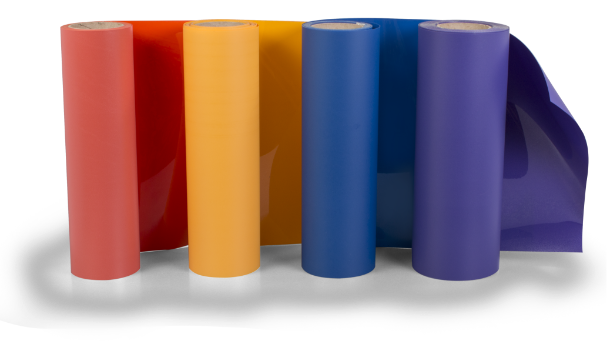
STAHLS’ Thermo-FILM athletic heat press transfer numbers are still the fastest, easiest way to personalize jerseys for all sports. They’re tough and they stand up to countless washings.
The History of Thermo-FILM
This week our tradeshow team is headed to the Impressions Expo in Atlantic City, New Jersey. Stahls’ has quite a history with both Impressions Magazine and the Imprinted Sportswear Shows. We’ve been there since the very beginning. Impressions magazine originally launched in 1977, followed by a trade show one year later. Although the first Imprinted Sportswear Shows were a little bit smaller, they were every bit exciting as they are today. We were so thrilled to have a trade show designed specifically for people who printed and sold T-shirts and sportswear.
And now, here’s some more information on the history of Thermo-FILM.
When we first introduced Thermo-FILM back in 1977 it changed the way people numbered sports uniforms—it was truly an innovation no one had ever seen before. But that doesn’t mean it was an instant best-seller. Back in the 70’s, the only heat transfer material for numbers was thick, heavy vinyl. It was difficult to use and had a reputation for falling off jerseys. Customers usually preferred screen printing over vinyl because the vinyl was so thick and the results were unreliable.
Thermo-FILM is a Better Way
We knew there had to be a better way—a thinner, lighter, more durable product. But since it didn’t exist so we had to invent it. I experimented with many different variations until we finally hit upon a combination of a urethane film with a lightweight polyester adhesive. It was a breakthrough—and a product people didn’t know they needed until they saw it in action.
The main method of marketing Thermo-FILM was through trade publication ads and more importantly, through live demonstrations at trade shows. My wife Mary and I were the first salespeople, showing customers how to heat press Thermo-FILM numbers onto shirts at hotel room shows and the early Impressions shows in Atlantic City. Sometimes we couldn’t even afford dinner until we sold enough numbers and letters. We learned a lot in those early days. People had to see, touch and feel Thermo-FILM to believe it worked,
Much of our marketing materials spoke about the strength and reliability of Thermo-FILM, that it would outlast the life of the garment. Garment decorators didn’t believe a product so thin and flexible would last. We even went so far as to carry rocks in our pockets to show customers how tough Thermo-FILM was. After applying a sample, we would let them try to scrape it off with a rock.
It took several years, but eventually our hard work paid off and more and more decorators recognized the immense amount of time Thermo-FILM could save them over screen printing numbers. They also understood that this was a product that sticks and stays. It became a world-wide sensation.
Polyester Adhesive
Thermo-FILM was the first HTV on the market with a polyester adhesive. And the first eco-friendly material, engineered with no PVC. Combine that with speed and ease of use, it’s a no brainer. Thermo-FILM can go onto anything. One of its best attributes is that it doesn’t bleed on polyester.
Every time we travel, everywhere we go, you can see people using Thermo-FILM numbers and letters. It’s on the back of your children’s and grandchildren’s Little League jerseys, soccer uniforms and just about any sport you can imagine.
Simply the Best
But it goes beyond sports. It’s one of best crossover products for crafters who are looking for a mistake-proof, premium HTV.
If you’re headed to Atlantic City this week, please stop by the Stahls’ booth and ask to see samples of our world-famous Thermo-FILM.


